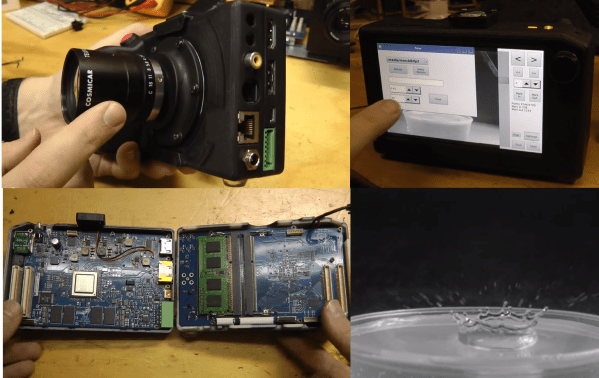[Tesla500] has a passion for high-speed photography. Unfortunately, costs for high-speed video cameras like the Phantom Flex run into the tens or even hundreds of thousands of dollars. When tools are too expensive, you do the only thing you can – you build your own! [Tesla500’s] HSC768 is named for the data transfer rate of its image sensor. 768 megapixels per second translates to about 960MB/s due to the 10 bit pixel format used by the On Semiconductor Lupa1300-2 image sensor.
This is actually [Tesla500’s] second high-speed camera, the first was HSC80, based upon the much slower Lupa300 sensor. HSC80 did work, but it was tied to an FPGA devboard and controlled by a PC. [Tesla500’s] experience really shows in this second effort, as HSC768 is a complete portable system running Linux with a QT based GUI and a touchscreen. A 3D printed case gives the camera that familiar DSLR/MILC shape we’ve all come to know and love.
The processor is a Texas Instruments TMS320DM8148 DaVinci, running TI’s customized build of Linux. The DaVinci controls most of the mundane things like the GUI, trigger I/O, SD card and SATA interfaces. The real magic is the high-speed image acquisition, which is all handled by the FPGA. High-speed image acquisition demands high-speed memory, and a lot of it! Thankfully, desktop computers have given us large, high-speed DDR3 ram modules. However, when it came time to design the camera, [Tesla500] found that neither Xilinx nor Altera had a FPGA under $1000 USD with DDR3 module support. Sure, they will support individual DDR3 chips, but costs are much higher when dealing with chips. Lattice did have a low-cost FPGA with the features [Tesla500] needed, so a Lattice ECP3 series chip went into the camera.
The final result looks well worth all the effort [Tesla500] has put into this project. The HSC768 is capable of taking SXGA (1280×1024) videos at 500 frames per second, or 800×600 gray·scale images at the 1200 frames per second. Lower resolutions allow for even higher frame rates. [Tesla500] has even used the camera to analyze a strange air oscillation he was having in his pneumatic hand dryer. Click past the break for an overview video of the camera, and the hand dryer video. Both contain some stunning high-speed sequences!
Continue reading “[Tesla500] Builds A High-Speed Video Camera”












